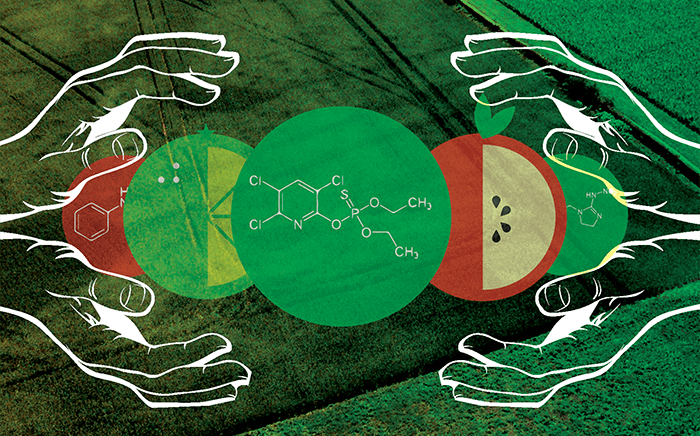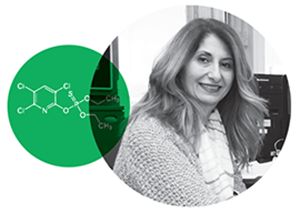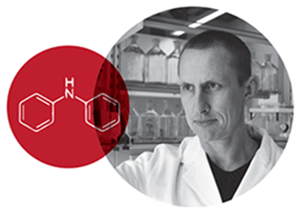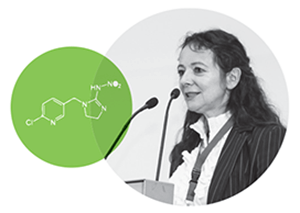
Pesticide residue analysis: is it as important as it used to be? Despo Louca Christodoulou: I’ll be bold and say it’s even more important than it used to be. To ensure the quality of the products – and maintain high productivity and remain competitive – more and more pesticides are used nowadays. The fact that pesticides may also harm humans has not gone away, so, of course, it is still necessary to ensure that residues are not present at levels that may cause risk to human health. Laboratories must be able to analyze an appropriate number of pesticides in food, meaning that we must apply both multi-residue and single residue methods. To do that, laboratories must be equipped with appropriate and increasingly sophisticated instrumentation whilst continually expanding their skills. Methods must have the appropriate sensitivity to satisfy all EU regulations. Put simply, I believe pesticide residue analysis is still a hot topic. Magnus Jezussek: I think it’s certainly as important as it used to be, but the media plays a bigger role now than ever before (for better and for worse). For example, we are likely to have controversial discussions about glyphosate – a hot topic in the media at least – questioning whether or not we should ban its use. All discussions about pesticide residue analysis tend to focus on consumers’ concerns – and we are here to ensure that we focus on the real risks. Sonja Masselter: I can highlight the importance with some figures. For example, if you look at the 2010 Eurobarometer survey, the results say that 31 percent of European citizens are concerned about pesticides in food. The perception of the consumers may be subjective – as Magnus notes with the discussion about toxicity of glyphosates – and the media certainly influences public perceptions of these hazards to a large degree. For the same reason, neonicotinoids in relation to bee mortality is also a very hot topic – and one we must be fully aware of. From 2015 until January 2016, the number of Rapid Alert System for Feed and Food (RASFF) notifications for pesticide residues was 422. 312 of these notifications concerned border rejections. Since the harmonization of maximum residue limits (MRLs) – Regulation (EC) No 396/2005 – we’ve observed a decrease of noncompliant samples in Austria.
Do you think public awareness is a good or a bad thing, generally? MJ: I think it’s good that the awareness of consumers has risen through various campaigns over the last ten years or so – at least in Germany. The important question remains: are pesticides harmful to people? High consumer awareness of the risks of pesticides ensures that it stays a hot topic ¬– and makes our work more relevant than ever before. DLC: I agree. And I’d like to add that more and more consumers are interested in organic products – but the interest also comes with a lot of questions. Consumers want and need more information, because they believe they are paying high prices for reduced risk – and they want proof of that fact. How did you become so heavily involved in the field? DLC: To be honest, in the beginning it wasn’t my decision but that of my director at the time! But it only took a few months before I realized that pesticide analysis was the job for me – mainly because of the many challenges. We have to deal with unknown samples and unknown pesticides, which means doing a great deal of complex method development – and working with new techniques and instrumentation. Let’s just say, you never get bored in pesticide residue analysis. SM: Unlike Despo, I made the choice to go in this direction. I was always fascinated about analytical chemistry in general and especially the instrumentation behind it. My thesis was about chlorophenols, which relate closely to pesticides. Back then – 20 years ago now – I started working at the Institute for Food Investigation, where my focus was the analysis of pesticides. Many things have changed since then, like miniaturization and automation, and I could write another thesis on that topic... But, as Despo says, it has always been very interesting, because of the challenging nature of the field. I also never get bored! MJ: My first contact with pesticide residue analysis was during my PhD thesis, which was in flavor science rather than residue analysis. Besides my research activities, I tutored students at the university and helped to establish a new method, based on SPE, to show how pesticide residue analysis works. I got a good view of how interesting this area was and after my time at the university, I applied to a position at the governmental lab here in Bavaria, which was perfect for me because it was in the pesticide residue area. I’ve been here ever since, as a deputy head and now head of the lab. I also get the chance to join a lot of working groups within the German pesticide residue community – it’s great fun to work with many colleagues on such a challenging topic.
Despo Louca Christodoulou
Is the Head of the Pesticide Residues Laboratory of the State General Laboratory, an Official Control and National Reference Laboratory of Cyprus. Despo has much experience in pesticide residues analysis in food of plant and animal origin, and in the analysis of PCBs in food. She is responsible for the National monitoring programs for pesticides and dioxins in food, and a member of the committee of the National Pesticides Council related to the registration of Plant Protection Products. Despo is also responsible for the harmonization of the National Legislation with EU directives, decisions and regulations related to pesticide residues and dioxins in food. She participates in EU Expert Groups and the Standing Committee of Pesticide Residues, and is chair EPRW2016.

Magnus Jezussek
Studied food chemistry at the University of Erlangen and received his PhD in the field of flavor research at the Technical University of Munich. He started his career at the pesticide residue laboratory of the Bavarian Health and Food Safety Authority in 2003. Since then, Magnus has mainly been working in the field of pesticide residues in food of plant origin. In 2006, he became head of the lab and, since 2012, has also been responsible for environmental contaminants, nitrosamines, radioactivity, and irradiation. He is a member of several national and international working groups, including the European Committee of Standardization (CEN), the EU PT & AQC Advisory Board and the pesticides working group at The Society of German Chemists.

Sonja Masselter
Born in Luxemburg, studied chemistry at the Leopold-Franzens University of Innsbruck and received her doctoral degree in analytical chemistry in the field of capillary electrophoresis. In 1995, she accepted a position as a scientific assistant at the Federal Institute for Foodstuff Inspection in Innsbruck, where she was responsible for the residue analysis of veterinary drugs, PAHs, pesticides, and radioactivity. In 2003, she became Head of the Competence Center for Pesticide Residues at the Austrian Agency for Health and Food Safety (AGES) in Innsbruck. After developing and enhancing the National Reference Laboratory (NRL) for pesticide residues, she was promoted to head of the AGES Institute for Food Safety. She is member of the EU PT & AQC Advisory Board, Scientific Organizing Committee member of EPRW and member of the Austrian Codex Sub-Committee.

The EPRW meetings give the impression of a very tight-knit community – is that the case? MJ: For me that’s definitely true – EPRW (as well as LAPRW and NACRW) – have a real community spirit. Like the working groups I mentioned, everyone is very open to exchanging ideas. And if you work in an official lab, you also have the chance to join in workshops run by the European Reference Laboratories (EURLs), which further adds to the strong sense of collaboration. SM: It is a very well connected and very much like a family; you meet the same people at different conferences, for example EPRW – and also workshops organized by the European Reference Laboratories. In fact, we have a lot of meetings where we can work together and exchange our experiences – good and bad. DLC: I agree with Sonja; it feels like we’re in a family when we meet each other. And not only do we exchange experiences but we also help each other solve difficult problems – even if we don’t always know each other personally. My commitment to ‘the family’ is proven by me chairing this year’s ‘reunion’ at the 11th European Pesticide Residue Workshop in Limassol, Cyprus (EPRW2016.com).
So, the emphasis is on collaboration rather than competition... DLC: Absolutely. There are so many challenges that collaboration is essential. We have to deal with many compounds – and the list gets longer every day. The regulations are also changing all the time – with lower MRLs or with new combinations of pesticides and foods – so we need to support each other to catch up or keep pace with new requirements. MJ: The most challenging part of our work today is the rising number of single residue methods we have to apply on samples, despite human resources and instrumentation remaining constant – it is definitely a challenge to do more work with the same resources as before. To that end, we are focusing on automation, wherever possible. DLC: I’d like to add that Cyprus is a very small country and so we don’t have the same human resources and instrumentation as the labs from the bigger member states. It makes our lives even harder, but the aim is the same: to expand our multi-residue methods and create new single-residue methods, which is the only way to comply with EU regulations and protect our countrymen. Another area we are involved in is (cumulative) risk assessment, which is the main reason for our participation in EuroMix, a “tiered strategy for risk assessment of mixtures of multiple chemicals” (co-funded by the European Commission and Horizon 2020). SM: It really is a big challenge to cover all pesticides, new pesticides and to establish single-residue methods. It results in a large workload with a simultaneous reduction of budgets and human resources. In our lab, we try to expand the scope for multi-residue and single-residue methods, as well as to include new commodities. We are now the National Reference Laboratory for all commodities except water and soil, meaning that we are also responsible for fatty matrices, which are very challenging in terms of sample preparation. As Magnus said, it is important to have methods that can be automated. And as Despo indicated, organic foods are becoming more popular, and we have observed an upward trend of non-compliant products; for example, for chlorates and perchlorates. MJ: I agree – the organics trend really is a hot topic at the moment.
Any other hot topics or trends? MJ: Sample processing is becoming increasingly important. As the number of methods increases (and as we only really get one shot at sample processing), it can be challenging to find a single process that’s suitable for all the analytical methods that must follow. As with all analytical endeavors, we are not only responsible for the assessment of the sample but also the suitability of the methods we use – including sample processing. SM: As Despo indicated earlier, cumulative risk assessment is one particularly hot area. Endocrine disruptors are another. I’ve already indicated organics – I think this will be a growing area of interest for some time. And then, of course, the use of unauthorized pesticides is always a very hot area in pesticide analysis. Something new to consider is the use of pesticides to prevent diseases, such as the Zika virus, spread by insects. It could become the next hot topic for pesticide analysis because we don’t know which pesticides will be used for that treatment – or what the knock-on impact may be. DLC: I agree with Sonja and Magnus, and will add that there will be a special “Themed Day” on sampling, sample preparation and sample processing at EPRW2016. These play a very important role in pesticide residue analysis, as they significantly contribute to the accuracy and variability of our measurements. There are pesticides that require special treatment, such as cryogenic milling – otherwise it is not possible to detect them. Sample preparation and processing also play a part in risk analysis, so it’s a topic that is likely to remain hot for many years.
Who are the people to watch in pesticide residue analysis? SM: In Europe, we always follow the example of the EURLs and for people working in there; for example, Michelangelo Anastassiades (single residue methods). They do very important work, such as providing information about validation of new analytical methods, training, and the organization of proficiency tests. Universities are also important; Jana Hajšlová at the Institute for Chemical Technology is one leader. Hans Mol at RIKILT is another. Private companies also have a lot to offer – especially as they often have more resources – that’s why they are welcome at EPRW. Instrument and device manufacturers can also really take the lead when it comes to new developments. DLC: It’s no surprise that we are keen to follow the scientific work of internationally renowned pioneers. And I agree with Sonja that the role of the EURLs on pesticide residues is very important. In addition to the methodologies that they propose, they provide us with training courses and try to solve problems with tricky pesticides and matrices. MJ: The heads of the EURLs – Amadeo Rodriguez Fernandez-Alba, Ralf Lippold, Mette Erecius Poulsen, to name a few more – are normally the triggers for new developments.
Are any areas neglected or in need of greater resources? MJ: A tricky question. I think we are good at what we do, but we typically do not know if we are missing something – until another lab discovers a new compound and a new challenge. But until we know we don’t know it – it’s not neglected as such! The main problem in terms of resources is the increasing number of methods for an increasing number of samples. SM: So true. We have had budget cuts in our institute but have more samples than we had a few years ago. It’s always hard to do more with less... DLC: I’d like to echo that and also add that the workload burden is compounded by the complex residue definitions that must be followed for compliance. Complex residue definitions consist of two or more compounds – but not all components can be analyzed with the same methods, so in many cases we have to develop more than one method for each definition. It’s time-consuming and costly (and significant numbers of compounds are not commercially available, which is a real problem) – ultimately, it’s another resource issue. And it’s the source of many discussions!
Is there a solution to the resource issue? SM: There is a constant drive to make analysis more efficient. We have to constantly strive to improve sample preparation (look how QuEChERS has evolved) while moving forward with faster or more sensitive instrumentation. We are beginning to look at high-resolution, full scan MS methods – and asking how non-targeted analysis can fit into routine labs. We are only at the beginning of installing such new technologies. MJ: I would add that it’s not just the high-tech end that can be improved upon; there are opportunities to increase efficiency at all stages by making it easier to do sample preparation and processing – using new robotic systems for dilutions and so on. It’s an area we really need to get to grips with.
If current methods are “good enough”, is there a need for constant refinement and such niche and dedicated conferences? SM: Improving pesticide residue analysis is a continuous process – you never stop and you can always improve – much like other analytical fields. The methods are certainly not bad, but we must analyze for more compounds using more single residue methods. And there is certainly always demand for improvement. That’s why EPRW is so important; it gives us the possibility to share knowledge and to discuss the latest important developments as a community. MJ: Much like the development of the QuEChERS method (first presented at EPRW 2002 in Rome by Anastassiades and colleagues), improvements readily come from exchange between laboratories and all the validation studies we do together. Conferences like EPRW are great for networking; we can link up and then work together to improve methods – not only on the analytical side, but also in areas of risk assessment and regulations. There is a huge amount of knowledge at conferences, so you can always find ways to improve your own lab and work. DLC: As 2016 Chair, it would be remiss of me not to mention that people from all over the world (not just the EU) have the opportunity to learn about the most recent developments in the analysis of pesticides at EPRW. I agree with Sonja that, although the methods used now in the community are good (according to the results of the proficiency tests organized by the EURLs), we will always need something better – something faster and more sensitive – because everything changes so quickly in pesticide analysis. New compounds appear and new developments must follow – I don’t think we can ever rely on ‘good enough’. Methods are only “good for the time being” – then we have to focus on making them better or more appropriate for more compounds. Developing methods should always be a dynamic process.
Should we be taking a more holistic approach – moving from multi-residue to multi-contaminant methods? SM: Over the last few years, we have seen many contaminants that used to be pesticides, such as chlorate, and though they are no longer used, they still appear in food. Therefore, we cannot separate pesticides and other contaminants completely – so we do need to use a holistic approach. And in the case of lower budgets, it is a good idea to take a multi-contaminant analysis approach. If I remember correctly, at EPRW 2016 there will be a presentation on a combined analytical approach for pesticides, mycotoxins and alkaloids. In the future, perhaps it will be increasingly important to work in this way. MJ: I have nothing to add to Sonja’s very comprehensive answer! DLC: As Sonja mentioned, there will be a presentation on a multi-contaminant method. And indeed, a strong focus of EPRW2016 is toxicology and risk assessment. And though it’s interesting to take a holistic approach to contaminants, it can be very difficult to assess the results, particularly with cumulative risk assessment, given all the aspects that must be considered. We must be aware of balancing our desire to assess more contaminants in one method with our ability to perform an accurate risk assessment. In my view, we have a long way to go... But it is a fascinating topic.
Given resource constraints – are we testing enough samples? Do we need more focus on throughput rather than sensitivity or accuracy? MJ: I think there is the need for a balance between throughput, sensitivity and accuracy. Of course, it would be great to have really cheap, fast and easy methods, but I don’t think that will happen for single residue methods any time soon. And if we want to look into a sample in detail, we can only focus on accuracy and sensitivity. SM: I can foresee the benefit of very easy measurement methods to increase throughput – but the sampling would still need to be done by a competent authority. We already analyze a lot of samples for pesticide residues and if we added in the internal control processes of private companies, retailers and wholesalers, that number would be significantly higher. Unfortunately, we don’t have access to that data – but that would certainly give us a better picture of global trends and risks. DLC: Accuracy and sensitivity are highly important aspects of residue analysis. It is essential to be able to detect the lowest possible concentration, as toxicity may appear in cases where there is exposure to several pesticides with common toxicity. Without accurate results, it is not possible to perform adequate risk analysis and nor is it possible to take action in those cases. We cannot say that we are going to analyze more samples with less sensitivity because this approach does not protect the consumers. When I think of fast and easy methods, my focus is on sample preparation – as Sonja mentioned earlier. If our sample preparation steps are easier and faster, we can spend more time on instrumental analysis and on evaluation of the results. We cannot become negligent in terms of accuracy and sensitivity, because we would lose the purpose of pesticide residue analysis and risk assessment. MJ: I agree with Sonja. We don't have the option to exchange accuracy and sensitivity for low cost and the possibility of really fast analysis. But I think it would be helpful to have cheaper and easier and faster methods that are as valid as the ones we have now. Cheap, easy, fast, highly accurate and highly sensitive methods – in other words, the Holy Grail.
What’s on your technology wish list? DLC: I would say we need an instrument that performs as well as time-of-flight (TOF) MS when it comes to the analysis of real (not targeted) unknown compounds, but that is less complicated in operation. MJ: Despo is spot on with that realistic point of view. As residue analysts, we need the development of instruments that are much easier to handle, especially in terms of the software and the evaluation of the results. We need methods (and instruments) that can be reliable in an automatic way. SM: I totally agree with my colleagues. First, we need instruments to go to very low levels of residues. The analysis also has to be robust; we have to avoid false positives or negatives. On the wish list in our lab are also high-end MS instruments, such as those based on Orbitrap technology. We have one top instrument but we can struggle with software that is not very user friendly, meaning that it takes a great deal of time to evaluate results. Maybe near infrared (NIR) spectrometry, which is already used for the authentication of food, is a technology that can also be applied to detect pesticide residues. On the other hand, perhaps we need a new direction of thought – one that could lead to new technology. In any case, I would say that even the best instrumentation cannot replace an analyst with extensive experience!
The 11th European Pesticide Residue Workshop (EPRW) will take place May 24–27, 2016, in Limassol, Cyprus. www.eprw2016.com




